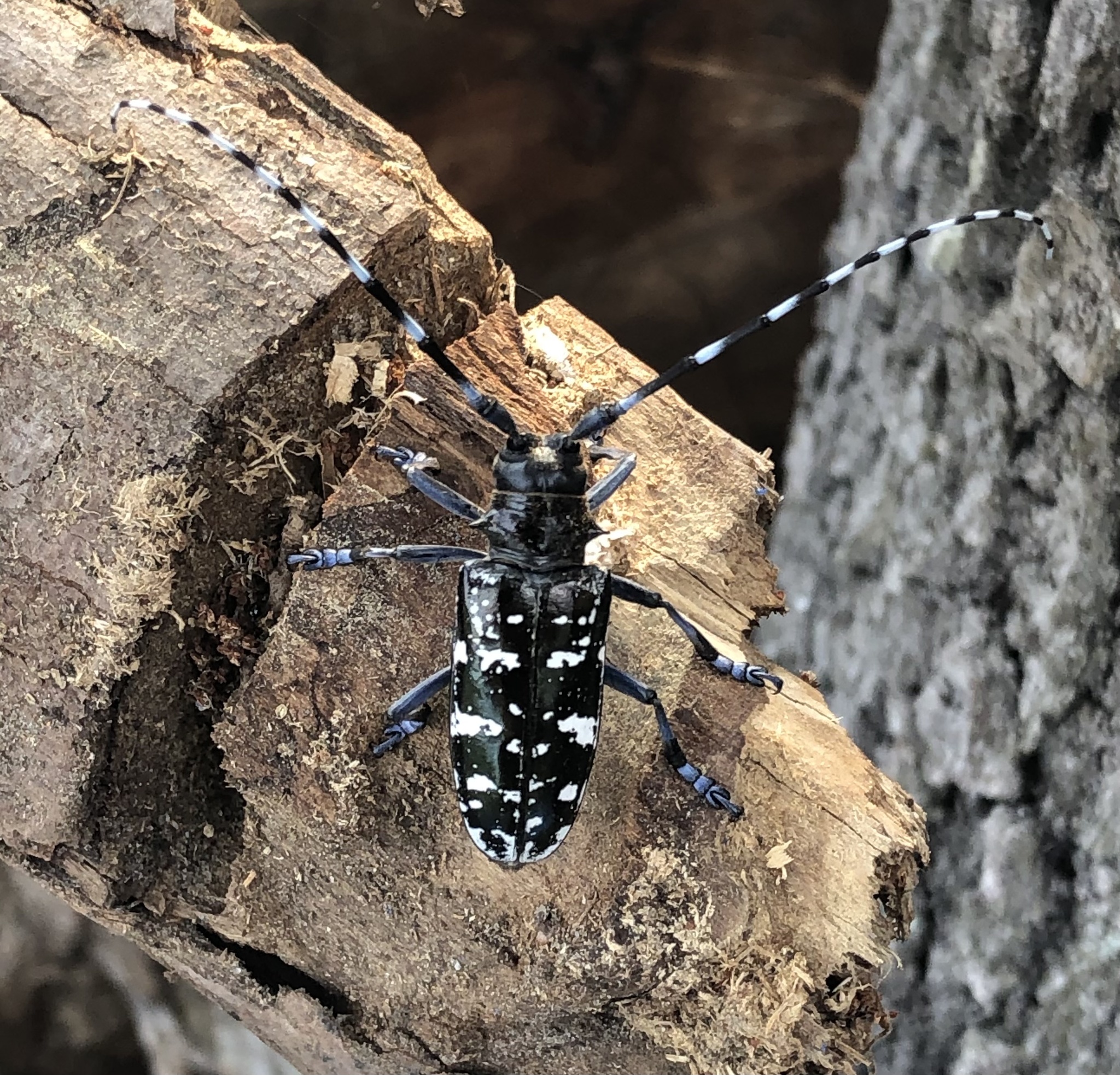By Carolyn Bernhardt
Since it was first detected in New York in 1996, the Asian longhorned beetle (Anoplophora glabripennis) has been an insidious threat to healthy hardwood trees nationwide. The striking black-and-white invader’s offspring tunnel deep into tree trunks as larvae, affecting beloved species like maple, birch, and elm. Today, managers mostly rely on cutting down infested trees and destroying them to curb the beetles’ spread.
But what if novel defensive strategies were lurking in nature? A new article published in June in Environmental Entomology reviews a promising lineup of microbial enemies—fungi, bacteria, and nematodes—that could help suppress Asian longhorned beetle (ALB) outbreaks. It’s the first comprehensive look at these natural biocontrol agents, and, according to lead author Ann Hajek, Ph.D., professor emerita at Cornell University, it’s long overdue.
“I was stunned that we had never written a review about this,” she says. When collaborating on a different review paper focused on parasitoids, Hajek noticed “there was far too much information about studies of pathogens” to merge the topics into a single review. That realization led to this second, standalone review focused squarely on these microbial enemies known as entomopathogens.
Fungal Frontlines
Among the most promising tools are insect-killing fungi, especially Beauveria and Metarhizium species. These fungi infect the beetles externally, their spores latching onto the beetle, entering the body, and eventually killing the beetle. In trials, beetles exposed to these fungi lived shorter lives, laid fewer eggs, and could pass pathogens to their offspring.
Researchers eventually developed a solution to strategically infect beetles: wrapping tree trunks with fungus-covered bands. A Japanese company had already commercialized fungal bands to manage related beetles in orchards. “We started with information about the Japanese product and adapted what we developed for ALB,” Hajek says.
But there was a hitch: The U.S. has prioritized eradication, not management. “The ALB populations in the U.S. were very low and scattered,” Hajek says. Once a tree is confirmed as infested, it’s swiftly cut down and chipped. That means U.S. researchers had no access to sustained beetle populations for field trials, so most of this work has had to take place in China, where ALB is native.
Hajek’s review combines findings from research conducted by others with studies she and colleagues have conducted in recent years. In these studies, field trials were successful, but some challenges emerged. The fungi require some moisture to work effectively, but ALB populations in China occurred in very dry regions. So, after several unsuccessful seasons with too few beetles or too-dry weather, the team discontinued field trials in China. In the U.S., testing shifted to evaluating how long the fungal bands remained viable outdoors, with researchers bringing samples back to Cornell’s quarantine lab to test infection potential.
Importantly, all tests in the U.S. used native or EPA-approved fungal strains—never imported ones. “We realized we needed to use U.S. isolates or fungi already approved by the EPA to develop a viable ALB control method,” Hajek says.
Hajek notes that these methods aren’t standalone solutions for eradication. But, she says, they could be powerful tools if ALB becomes more widespread or more complex to contain, especially if paired with other potential and emerging strategies, like pheromone lures to draw beetles to the bands.
Other Contenders
While fungi target adult beetles, tiny parasitic worms known as entomopathogenic nematodes set their sights on the larvae. Two species—Steinernema carpocapsae and S. feltiae—proved most effective in lab trials. These nematodes crawl into beetle tunnels and are especially attracted to beetle droppings. Once inside, the nematodes kill ALB larvae within days.
The team also tested Bacillus thuringiensis (Bt), a bacterium already used in many natural biopesticides. But because ALB larvae live deep inside trees and rarely feed on exposed surfaces, Bt isn’t currently practical for field use. Another candidate, Nosema glabripennis, a microsporidium found infecting beetle larvae in China, hasn’t yet been detected in U.S. ALB populations, but scientists are still searching.
Why Aren’t These Tools in Use?
Despite the promise of these natural enemies for managing Asian longhorned beetle, fungal bands or nematodes have not been deployed more broadly in the U.S. because of the country’s aggressive and largely successful eradication approach through other means. Outbreaks remain relatively rare and localized, thanks to vigilant public reporting and swift tree removal. Biological controls like fungal bands are more useful for population suppression than eradication. For now, they remain a backup plan—tools that could be scaled up if outbreaks worsen or if managers need spot treatment options to supplement other control measures.
Hajek believes the U.S. could follow Japan’s lead, where fungal bands are already commercialized and in use. “I think it would be possible for industry in the U.S. to do this too, when needed,” she says.
Even in retirement, Hajek remains passionate about this particular beetle battle. She credits citizen scientists for playing a crucial role. “The last I knew, all ALB infestations were first found by the public! So, the public has been super important to detecting ALB in the U.S.,” she says.
In the ongoing fight against this tree-killing invader, fungi, worms, and microbes may not be miracle cures—but they’re powerful potential allies waiting in the wings.
Carolyn Bernhardt, M.A., is a freelance science writer and editor based in Portland, Oregon. Email: carolynbernhardt11@gmail.com.
Related
Discover more from Entomology Today
Subscribe to get the latest posts sent to your email.
